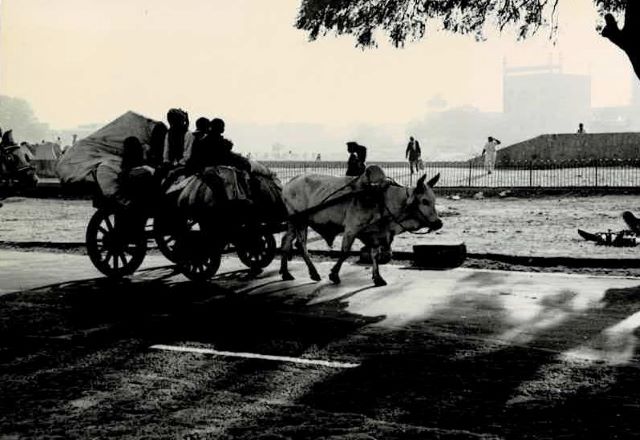
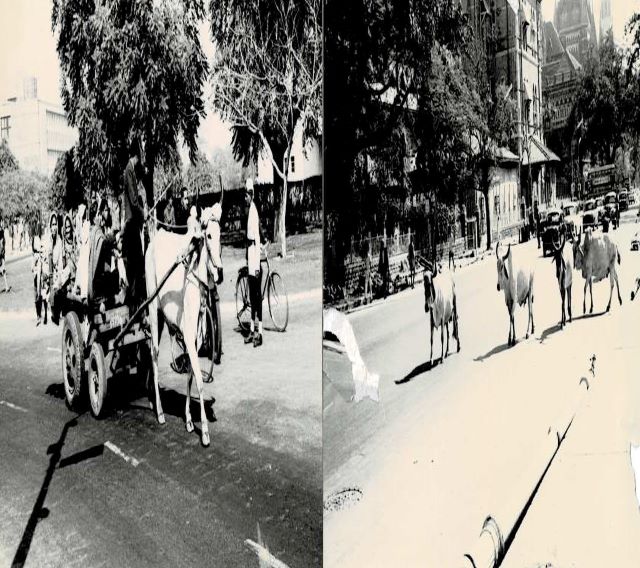
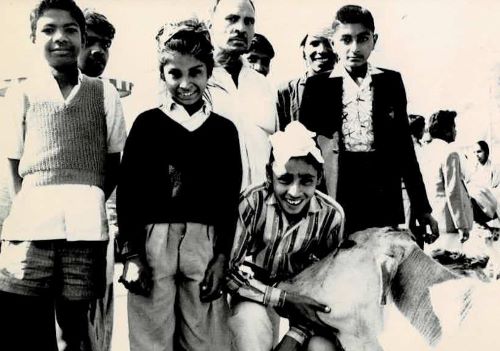
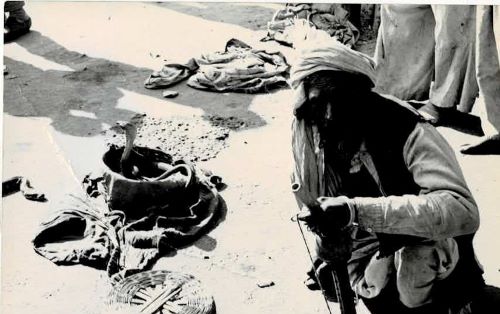

インドは別宇宙
生死は輪廻転生、無限に生まれ変わる。インドの大地を歩くと足裏から命が忍び込む感じがした。大きな命のプールに生と死が重なっていた。水が「液体、個体、気体」と変化するように、「命は水」のようでもあった。
現代でも変わってはいない。
ガンジーを生む大地である。
小乗と大乗仏教
インダス文明
Indus Valley civilization
インダス文明は、
BC2600年からインダス川流域に栄えた文明である。
BC1800年頃の洪水や気象変動によって
急速に衰えた。
The Indus civilization A civilization that flourished in the Indus Valley since 2600 BC. Due to floods and weather changes around 1800 BC declined rapidly.
BC1500年頃、
中央アジアに住んでいたアーリア人(Aryan)が
インドのパンジャブ地方に押し寄せ
先住民を支配下においた。
アーリア人は部族単位に村落に住み、
農耕と牧畜を行った。
Around 1500 BC,
Aryans who lived in Central Asia
Invade India's Punjab region
controlled the natives.
The Aryans lived in villages in tribal units,
They farmed and raised animals.
牛を神聖視する風習や
カースト制度(caste)は
この頃に始まり現在も続いている。
輪廻転生する魂
良き階級への生まれ変わりを願い皆が生きる
The custom of treating cows as sacred and the caste system began around this time and continue to this day.
The soul reincarnates in circles and wishes to be reborn into a good class.
カーストは、
バラモン(司祭)、
クシャトリア(士族)、
ヴァイシャ(庶民)、
シュードラ(隷民)の
4つの身分制度で、
現世では
カースト間の移動や結婚は認められず、
カーストは親から子へ受け継がれた。
Castes are divided into four classes: Brahmins (priests), Kshatriyas (nobles), Vaisyas (commoners), and Shudras (servants).
in this world
In the caste at birth, moving to another caste or marrying between different castes is not allowed.
Caste was inherited from parents to children.
現在は、憲法でカーストが全面禁止されているが、
実際はインド社会に深く根付いている
彼らは自然現象を崇拝し、
神である雷や太陽に供物と賛歌をささげた。
この賛歌と儀礼をまとめたものが
ヴェーダで、
最古のものがリグヴェーダ(Rigveda)である。
Currently, the caste system is outlawed by the constitution.
However, it is deeply rooted in Indian society. Bindu worship natural phenomena,
They offered offerings and hymns to the thunder and the sun.
This collection of hymns and rituals
It is the Vedas.
The oldest is the Rigveda.

新宗教
仏教(小乗)の誕生
new religion
Birth of Buddhism (Hayana)
ゾロアスター教はアーリア人の祭司だった
(英語名:ゾロアスター Zoroaster)によって開かれた。彼が30歳の時、天使ウォフ・マナフ (Vohu Manah) に導かれて正義の神アフラ・マズダ(Ahura Mazda)に出会い啓示を受けた。アーリア人は多くの神を信じていたが、ザラスシュトラは、アフラ・マズダこそが唯一の神であると説き、
アフラ・マズダの言葉を人々に伝え始めた。
彼は世界最古の預言者といわれている。
ゾロアスター教の教えである
一神教、天国と地獄、最後の審判などの
概念は、
他宗教に大きな影響を与えた。
Zoroastrianism was an Aryan priest
(English name: Zoroaster Zoroaster) opened. When he was 30, he was led by the angel Vohu Manah to meet Ahura Mazda, the god of justice, and receive revelation. The Aryans believed in many gods, but Zarathustra preached that Ahura Mazda was the only god and began to pass on the words of Ahura Mazda to the people. He is said to be the world's oldest prophet. Zoroastrian teachings such as monotheism, heaven and hell, and the Last Judgment have greatly influenced other religions.
+
先住民の宗教=バラモン教
バラモン教はヴェーダを聖典とし、
天・地・太陽・風・火などの
自然神を崇拝した。
この世で行った行為(カルマ)によって、
次の世の
生まれ変わりが決まる(輪廻)と説いた。
人々は良い状態に生まれ変われるようにと
解脱の道を求めた。
Indigenous religion = Brahmanism.
Brahmanism used the Vedas as scriptures and worshiped nature gods such as heaven, earth, sun, wind, and fire.
Brahmanism preached that the deeds (karma) performed in this world determine the reincarnation in the next life (reincarnation).
People sought the self-shedding of the soul so that it could be reborn in a better state.
BC500年頃、
新しい思想としてジャイナ教と仏教が生まれた。
ジャイナ教(Jainism)は、
人間は苦行によって救済されると説いた。
不殺生主義でもある。
Around 500 BC, Jainism and Buddhism emerged as new ideas.
Jainism preached that humans are saved by penance.
It is also non-killing.
仏教・釈迦
Buddhism, Buddha
釈迦族の王子として裕福な生活を送っていたが、
29歳で出家した。
35歳で悟りを開き仏陀となった。
そして、その悟りを説いて廻り、
80歳で入滅(死去)した。
釈迦が産まれた時、七歩歩いて右手で天を、
左手で地を指し
「天上天下唯我独尊」と話したと言われている。
ほどなく母の摩耶(まや)は亡くなり、
母の妹によって育てられた。
釈迦は父浄飯王の期待を一身に集め、
多感で聡明な青年に育った。
16歳で母方の従妹と結婚し、一子をもうけた。
子供ができて跡継ぎ問題が解決した
29歳の時、出家した。
6年間、厳しい修行を積んだが、
「苦行は心身を消耗するのみで、
人生の苦を解決することはできない」と悟った。
釈迦は苦行を打ち切り、
ガンジス河の支流ナイランジャナー河(尼連禅河)で
沐浴し、
疲れきった体を休めた。
まさに、瀕死の状態だった。
そこに村娘スジャータが通りがかり、
牛乳かゆを飲ませて命を救った。
彼女は、
「琴の弦は締めすぎると切れてしまう、
締め方が弱いと音が悪い、
中くらいに締めるのが丁度良い」 と
唄った。
それから釈迦は、
ガヤー村の菩提樹の下で、
49日間の観想に入った。
そして、12月8日未明に悟りを開く。
35歳の時であった。
ガヤー村は、仏陀の悟った場所、
ブッダガヤ(仏陀伽耶)と呼ばれた
He lived a wealthy life as a prince of the Shakya clan, but became a priest at the age of 29.
At the age of 35 he became enlightened and became a Buddha.
And he went around preaching that enlightenment, and died at the age of 80.
When Buddha was born, he walked seven steps and pointed with his right hand to heaven and his left hand to earth.
He is said to have said, "I am the only one in the world."
His mother Maya died shortly after, and he was raised by her mother's sister. Shakyamuni grew up to be a sensible and intelligent young man who gathered the expectations of his father Johan King.
At the age of 16 he married his maternal cousin and had one child. Having a child solved the succession problem. When he was 29, he became a monk.
For six years he underwent a rigorous training. However, he realized that his asceticism would only exhaust him physically and mentally and could not solve his life's woes.
Buddha ended his penance,
On the Nairangjana River, a tributary of the Ganges River
He took a bath and rested his weary body.
He was, he was dying.
There his village daughter Sujata passed by and she gave her milk porridge and saved her life.
"If you tighten the strings of the koto too much, they will break.
If the tightening method is weak, the sound is bad,
A medium tighten is just right," she sang.
From that time on, the Buddha sat under the Bodhi tree in Gaya Village,
He went into 49 days of contemplation.
Then, in the early hours of December 8th, he attains enlightenment.
He was thirty-five years old.
Gaya Village is the place where Buddha attained enlightenment.
Called Bodh Gaya
釈迦のカースト否定
全ての人間は平等で
輪廻転生の否定
正しい道(八正道)を行うことによって
自己からの解脱をする
生・老・病・死
一切は苦
逃れられる道は
諸行無常
この世の現象は因縁によっておこり、一切は常に変化し、不変のものはない
諸法無我
(自己には実体はない)
涅槃静寂
煩悩の炎の吹き消された悟りの世界(涅槃)は、
静やかな安らぎの境地(寂静)であるということ
birth, old age, sickness, death
life is hard
The way out is
Realize that phenomena in this world are caused by fate, that everything is constantly changing, and that nothing is permanent.
Therefore, the self realizes that it has no substance.
Obtaining the world of enlightenment (nirvana) where the flames of worldly desires have been extinguished,
Acquire the tranquility of quiet peace
釈迦の遺言
「すべては移ろいゆくもの、
怠ることなく修行を完成させなさい。」
Buddha's testament
"Everything is transitory,
Complete your training without neglecting it. ”
四諦(苦集滅道)
正見、正思、正語、正行、正命、正精進、正念、正定
死後の魂を否定し
限りなく生と死を繰り返す輪廻の生存を苦と見、
二度と再生を繰り返すことのない
解脱を最高の境地とする生き方
Seeing life in a cycle of endless cycles of life and death as bitterness,
never play again
Liberation is the highest state of life

古代統一国家の成立
仏教政治普及
Establishment of an ancient unified nation
Buddhism political spread
BC4世紀頃、
北インド全体が統一された
マウリヤ朝(Maurya:BC317~BC180)。
アレキサンダー大王のインド侵入を抑え込んだ。
ギリシア人勢力をインダス川流域から追い払った。Around the 4th century BC,
North India unified
Maurya Dynasty (317 BC-180 BC).
Suppressed Alexander the Great's invasion of India.
drove the Greeks out of the Indus valley.
アショーカ王(Ashoka:BC268~BC232頃)は、
仏教を厚く信仰し、
仏教に基づく徳治政治を行った。
また、全国に石柱碑や磨崖碑を作り、
仏典結集(仏典の編纂)を行った。
King Ashoka (Ashoka: around BC268-BC232)
a strong believer in Buddhism,
He practiced virtuous rule based on Buddhism.
He also made stone pillars and stone monuments all over the country,
He compiled Buddhist scriptures

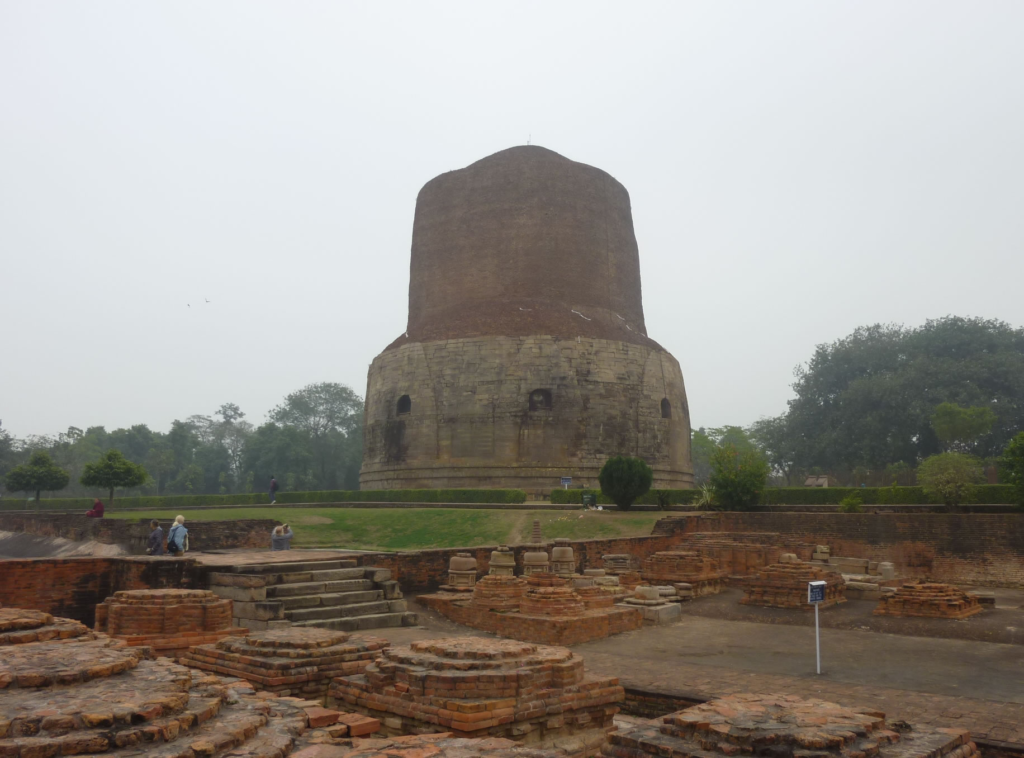
(サールナート インド)
クシャーナ朝 Kushan(3世紀)
大乗仏教の誕生
キリスト教との接点
Kushan dynasty Kushan (3rd century)
Birth of Mahayana Buddhism
contact with Christianity
クシャーナ朝カニシカ王
(Kanishka:130~170頃)
最盛期で中央アジアからガンジス川流域を支配した。Kushan Dynasty King Kanishka
(Kanishka: around 130-170)
At its peak, it ruled from Central Asia to the Ganges River basin.
ガンダーラ美術と呼ばれる仏教美術が開花
カニシカ王も厚く仏教を信じ、仏教は大いに栄えた。
このころヘレニズム文化の影響を受けて
仏像が作られるようになった。
Buddhism art called Gandhara art blooms
King Kanishka also believed deeply in Buddhism, and Buddhism prospered greatly.
Under the influence of Hellenistic culture
Buddha statues were made.
釈迦が否定した偶像崇拝
仏像を拝むことで始まる
✙
大乗仏教の誕生
従来の個人修行の自己救済から
祈りによる万人救済へ
大乗仏教がうまれた。
これらは中央アジアを経て、
中国、朝鮮、日本に伝えられた。
Idolatry denied by Buddha
Start by Worshiping a Buddha Statue
✙
From personal relief through conventional personal training
Change to universal salvation through prayer.
Mahayana Buddhism was born.
through Central Asia,
Introduced to China, Korea and Japan.
大乗仏教は、出家による自力救済を説く
小乗仏教(阿含経)の世界観・救済観と異なりる。
Mahayana Buddhism preaches self-salvation by becoming a monk
It differs from the world view and salvation view of Hinayana Buddhism (Agon Sutra).
小乗仏教の布教縮小の危機感から
生まれた新仏教である。
大乗仏教に分類される代表的な仏教経典としては、
般若経(般若心経はその核心)、
法華経、浄土三部経、華厳経、
涅槃経、大日経、金剛頂経などが挙げられる。
(経典分類はウイッキぺディアから参照)
It is a new Buddhism born out of a sense of crisis from the reduction of Hinayana Buddhism.
Typical Buddhist scriptures classified as Mahayana Buddhism are:
Hannya Sutra (Heart Sutra is its core),
The Lotus Sutra, the Three Pure Land Sutras, the Kegon Sutra,
These include the Nirvana Sutra, the Dainichi Sutra, and the Vajra Sutra.
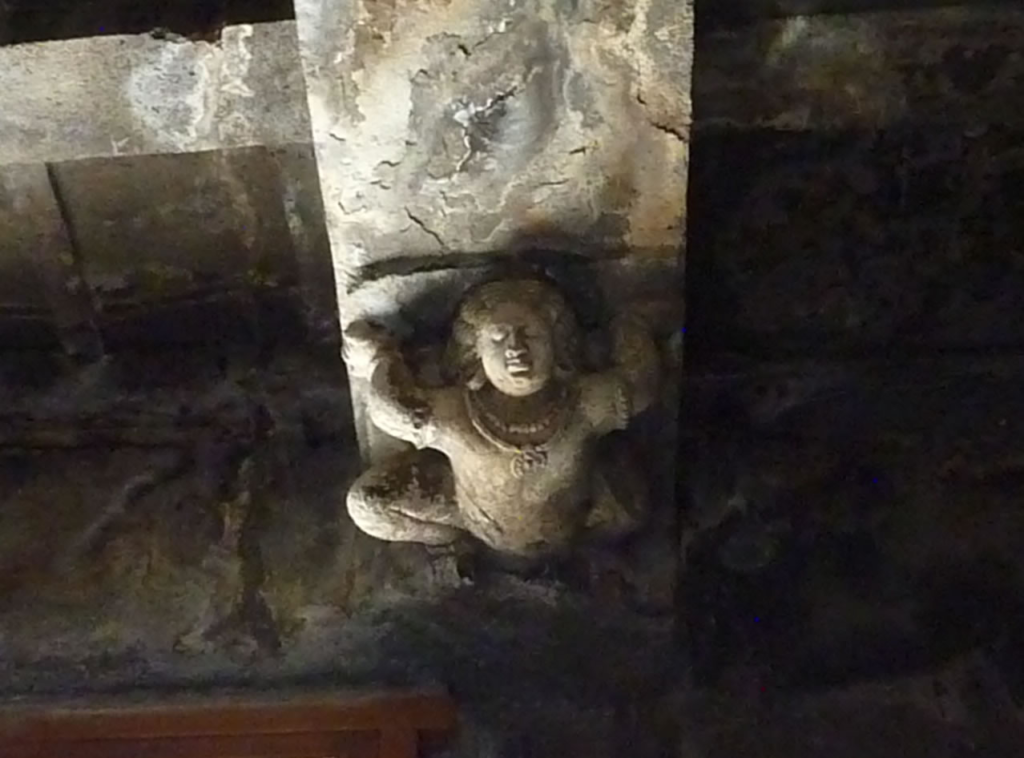
遺跡の天井を支えるアトラス(アジャンタ石窟16窟 インド)
グプタ朝 Gupta
ヒンズー教の隆盛
バラモン教+ジャイナ教+仏教=ヒンズー教
Gupta Gupta
Rise of Hinduism
Brahmanism + Jainism + Buddhism = Hinduism
ゼロの発見
その後
ヒンドゥー教が徐々に仏教を圧倒していった。
サンスクリット文学が栄え、
ヒンドゥー教の経典もこの頃に作られた。
医学や数学、暦の発達も著しく、
10進法やゼロの概念はイスラム世界に伝えられ、
自然科学発展の基礎となった。
Finding Zero
after that
Hinduism gradually overwhelmed Buddhism.
Sanskrit literature flourished, and the Hindu scriptures were created around this time. Medicine, mathematics, and calendars also made remarkable progress, and the decimal system and the concept of zero were introduced to the Islamic world and became the basis for the development of natural sciences.
ヴァルダナ朝 Vardhana 606年、
ハルシャ・ヴァルダナが北インドを統一た。
唐の玄奘が仏教を学びに
ナーランダー僧院(Nalanda)を訪れた。
西遊記に出てくる三蔵法師のことである。
Vardhana dynasty 606,
Harsha Vardhana unified northern India.
Xuanzang of Tang to study Buddhism
He visited the Nalanda Monastery.
It is about Sanzo Hoshi, who appears in Journey to the West.

ハルシャ・ヴァルダナの死後、地方政権が乱立。
イスラム教徒の侵入が始まった。
インド仏教の死滅。
After the death of Harsha Vardhana, the local governments were overrun.
Muslim invasion began.
Death of Indian Buddhism